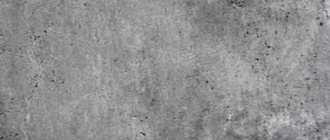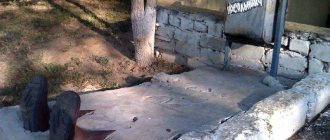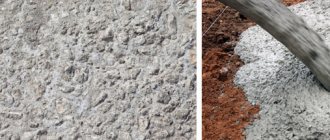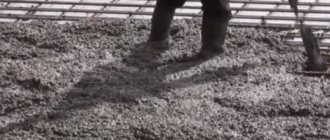Home |Types of concrete |Characteristics and proportions of M350 concrete
Date: November 20, 2017
Comments: 1
In the construction industry, concrete mixtures with increased strength are used for the manufacture of loaded structures. In terms of durability and strength characteristics, they confidently compete with natural stone, the use of which increases the cost. One of these building materials is M350 concrete. This is a material for structural purposes that is capable of withstanding significant loads and also has increased resistance to external influences. In terms of sales volume, it is the leader among other brands of concrete.
Composition and proportions
Brand M350 refers to heavy types of concrete. Composition of concrete mortar:
- binder – Portland cement grade M400-M500;
- coarse filler – crushed stone (gravel, granite, limestone);
- fine filler – sand (river, quarry or expanded clay);
- water without impurities. According to the requirements of GOST 23732-2011, it should not contain foreign substances that could deteriorate the properties of the finished concrete mixture;
- chemical additives to impart specific properties to the solution (plasticizer, antifreeze additives, accelerating or slowing down the additive hardening process).
To obtain high-quality M350 concrete, it is important to consider the brand of cement used:
- if Portland cement grade M400 is selected, then the ratio of components will be 1 part of cement; 2 parts sand; 3.3 parts crushed stone;
- if Portland cement grade M500 is taken, then the ratio will be different - 1 part of cement; 1.8 parts sand; 3.5 parts crushed stone.
Concrete recipe M350
To obtain a high-quality solution with increased strength characteristics, it is necessary to maintain proportions. Concrete M350 can be made independently or ordered from a specialized construction organization. The amount of ingredients added varies depending on the brand of Portland cement used.
When dosing the components of the mixture by weight, the following ratios should be observed:
- per ton of M400 cement it is necessary to use 3.1 tons of crushed stone and 1.5 tons of sand;
- when using 1 ton of M500 cement, 1.9 tons of sand and 3.6 tons of crushed stone will be required.
Using a measuring container, in some cases, volumetric dosing is convenient. The following recommendations should be followed:
- Portland cement grade M400 in a volume of 100 l should be mixed with crushed stone - 280 l and sand - 140 l;
- For 100 liters of M500 cement, 190 liters of sand and 360 liters of crushed stone should be added when mixing.
The quality of the monolith is influenced by the uniformity of mixing of the components, as well as strict adherence to the recipe. To ensure the technical and operational properties of the structure being built or the product being manufactured, the amount of input ingredients must be correctly calculated.
By using additives, the class of concrete varies over a wide range
Production technology
The production of mortar for any brand of concrete is identical. It is only important to comply with all technological conditions. Then you will get a high-quality solution of the required consistency, which will ensure the durability and strength of the structure being poured.
Even a small error in the production process can lead to a decrease in the quality properties of concrete.
The process of producing concrete for private and industrial construction is almost the same and includes a strict procedure:
- Preparation of the main components of the solution. Includes washing, cleaning and sifting of dry fillers - sand and crushed stone. The water is filtered to prevent the presence of various suspensions and particles in it. Portland cement is suitable only for recently produced cement, which has not yet had time to compact and form lumps.
- Mixing components. First, the dry fillers and Portland cement are mixed. Lastly, add water and mix until smooth.
In private construction, mixing can be done manually or in a small-volume concrete mixer. Concrete plants use concrete mixers (planetary, twin-roll, disc), which allow mixing huge volumes of mortar.
Uniform distribution of components in the solution guarantees the strength and durability of the structures being poured.
- Compliance with technological production conditions. Kneading should be done at a temperature of 20 ℃ and a humidity of 40-60%. It is important to maintain these indicators throughout the entire time – from mixing the components to delivering the concrete to the construction site. Otherwise, the mixture will separate and it will lose its properties.
The cement is mixed until smooth. For private construction, the mixing time depends on the fraction of the components. In factory conditions, this is solved computerized - depending on the application and the scope of application of the concrete.
Main characteristics of B25 (M350)
Another common issue is the cement used. More precisely, what brand: B25 concrete is the name of the class. And on the market, cement mixture is sold in bags with the designation M100, M200 and nothing similar to B25.
The types of cement used for concrete are M350 - M400 or M500. They differ in cost and proportions when making the mixture.
It doesn’t matter what is chosen, M400 or M500, the main thing is compliance with the required technical process.
The characteristics will remain the same in any case. To make it easier to understand, I present them in table form:
| Parameter | Meaning |
| Frost resistance | F200 (withstands two hundred frosts and thaws) |
| Waterproof | W6-W8 (protects against precipitation, groundwater and melting snow) |
| Workability | P2-P4 (has high mobility due to plasticizers) |
| Density of concrete | Reaches 2500 kg/m² |
| Withstands pressure | 327 kg/cm² |
So, despite its large size, a person cannot lift a cube of concrete. Yes, even with a height of one meter eighty, I could barely move the bucket with one hand! The mass of concrete is so huge that there is nothing surprising in its properties - density and hardness do not come out of nowhere. And now I will tell you what this huge weight of concrete is formed from.
Properties and characteristics
Concrete grade M350 must comply with GOST 7473-2010, which precisely determines the quality characteristics of the building material:
- in terms of compressive strength, the indicator of which is 327 kg/cm2, corresponds to class B25;
- the finished structure can withstand up to 200 cycles of freezing followed by defrosting, which classifies concrete M350 in frost resistance class F200. This means that concrete is suitable for the construction of buildings in areas with harsh climates;
- the high ability to retain moisture ensured the W8 water resistance class. The finished product does not contain pores and has a dense structure;
- the finished solution has a mobility of P2-P4. The value can be increased by adding appropriate additives;
- according to the degree of hardness it is designated as Zh3-Zh4. This brand of concrete is suitable for pouring load-bearing beams and floors of buildings under construction.
Additional technical specifications
By agreement between the manufacturer and the consumer of the B25 concrete mixture, additional technical characteristics of materials that are important when performing monolithic work can be standardized. These characteristics include:
- density of concrete at design age according to GOST 12730.1-78;
- heat generation during setting and hardening according to GOST 24316-80;
- elastic modulus according to GOST 24452-80;
- shrinkage and creep according to GOST 24544-81;
- wear resistance (endurance) according to GOST 24545-81;
- crack resistance according to GOST 29167-91;
- bending strength and axial tensile strength according to GOST 10180-2012;
- fire resistance according to GOST R 52541-2006.
Concrete mortar M350 for pouring special structures is standardized according to such technical characteristics as: homogeneity - transport concrete, hydrophobicity and resistance to sea water - hydraulic concrete, shielding properties - concrete for nuclear power plants, heat resistance - concrete for blast furnaces, corrosion resistance - for concrete with metal structures.
The technical characteristics of class B25 concrete mortar are indicated in the technical specifications, specifications or design documentation for the structure.
Areas and features of application
Concrete grade M350 is well suited for structures that must have increased strength and durability:
- pouring the foundations of buildings under construction;
- arrangement of staircases;
- pouring load-bearing walls and partitions;
- base for swimming pools;
- pouring reinforced concrete piles in private construction;
- bridge support beams;
- strengthening the road surface.
Concrete grade M350 is an indispensable material in the construction industry, valued for its high-quality composition and strength.
Technical description of concrete B25
The properties of a cement composite are determined by its composition. Manufacturers of the material are regulated by state standards 26633-2012 and 7473-2010. These are updated GOSTs from 1991 and 1994, respectively. Compared to other brands of cement mortar, M350 occupies a leading position in demand. Let's look at the reasons for this situation, which are based on the properties of the material.
Compound
Let's look at what components are included in concrete B25 grade M350. The basic ingredients are:
- Cement. The binder here must be of a high grade. Most often this is Portland cement from M400 (CEM I 32.5H).
- Sand. The material acts as a sealant. The purified component is used with a fraction of 1.5 to 2.5 mm.
- Gravel. Solid aggregate is usually limestone or granite in nature. The grain size is average, ranging from 20 to 40 mm.
Let's look at the recipe for concrete B25 grade M350 in the table below. Here is the dependence on the binder used.
| Components | For CEM I 32.5H (M400) | For CEM I 42.5H (M500) | ||
| In kg | In volumetric parts | In kg | In volumetric parts | |
| Cement | 1 | 1 | 1 | 1 |
| Sand | 1,5-1,6 | 1,1-1,4 | 1,9 | 1,6 |
| Coarse aggregate | 2,7-3,1 | 2,4-2,8 | 3,6-3,9 | 3,2 |
See also: Catalog of companies that specialize in calculation, installation and repair of foundations
It also contains pure water with minimal impurities. Liquid content is limited to 45%. It is permissible to additionally add additives to adjust characteristics such as frost resistance, mobility or hydrophobicity.
Plasticizer for concrete mortar Source stroysam-shop.ru
Properties
Based on the M350 B25 marking, the user can determine the strength properties of concrete. Thus, this composite is on average capable of withstanding a compressive load ranging from 327 to 368 kgf/sq.cm. The guaranteed strength (with an error of 5-7%) is 25 MPa, but it is possible to increase the limit to 27.5 MPa.
Other technical characteristics of the material are presented in the table below.
| Density | 1800-2400 kg/cub.m | The relatively wide range of values can be explained by the nature and fraction of the solid aggregate. This particular composite is characterized by high resistance to compression and tension during seasonal changes in the soil. |
| Frost resistance (F) | 200 | The numerical value indicates the permissible number of freezing and thawing cycles of the composite. M350 concrete can be used to form structures in harsh climates. |
| Waterproof (W) | 6-8 | Less commonly, a solution with a W10 index is produced with the addition of additives. The composite has low water absorption (up to 5.5% per day) due to its high density. There are practically no pores here. Therefore, the monolith is applicable to operation in conditions of direct contact with water. |
| Mobility (P) | 2-4 | The plasticity of the working mass is determined by the settlement of the conical sample. Cement mortar B25 is characterized by indicators of 5-9, 10-15 or 16-20 cm. To improve mobility, plasticizers are added to the composition. |
Why class B25
As already mentioned, class B25 concrete is usually redundant in private housing construction, but given the lack of accurate calculations and non-compliance with preparation technologies, it provides the necessary safety margin. Thus, when using a conventional electric concrete mixer designed for preparing masonry mixtures or when manually mixing in a bucket, it is almost impossible to maintain the correct ratio of water and cement, as a result of which the actual parameters of the concrete do not correspond to the declared ones. In addition, let’s not forget that the concreting process must be continuous, with vibratory compaction of the solution, which is rarely done in practice.
Applications and advantages of hydraulic concrete
Various objects are built from hydroconcrete above and below water:
- dams;
- dams;
- gateways, etc.
In addition, material with high waterproofing characteristics is used for the construction of runways, highways, and radiation shelters. It is also used to build structures in the Far North, where buildings are exposed to harsh climatic influences.
Due to the physical and chemical characteristics, the main advantages of hydroconcrete have been formed:
- waterproof regardless of operating conditions;
- immunity to temperature changes;
- high strength compared to building mixtures of standard brands.
At the same time, hydraulic concrete is more expensive than other types of mortars, and its installation requires special knowledge and skills.
Main advantages
The advantages of the material include:
- increased strength of concrete M350 - ready-made concrete mass, resistant to destruction under compressive and abrasion loads;
- high mobility of the solution (adding plasticizers increases elasticity) - the material is easy to install;
- the ability to carry out concrete work all year round, if necessary, increasing the frost resistance of the solution by introducing additives;
- long service life of the concrete monolith - it is resistant to all types of external influences;
- high density concrete M350 – monolithic structure is resistant to moisture accumulation and can withstand high loads;
- environmental friendliness - the raw materials used do not have a harmful effect on human health and the environment.
What are the advantages of grade 350 concrete?
This brand of concrete has numerous advantages:
- increased strength properties. The concrete mass does not collapse under the influence of significant compressive loads, as well as during active abrasion of the surface during operation;
- high degree of mobility. This makes it easier to carry out concrete work, and the use of special plasticizers can further increase the elasticity index;
- adjustable frost resistance. At the stage of preparing the solution, it is possible to ensure the required level of frost resistance to maintain the integrity of the monolith in difficult conditions;
- long service life. The composition of the M350 brand retains its original strength characteristics for a long time and is not destroyed under the influence of aggressive factors;
- increased density. Thanks to the effective compaction of liquid concrete, there are no cavities or air pores in the mass. This significantly increases the degree of water resistance and expands the possibilities of application;
- environmental cleanliness. For production, environmentally friendly raw materials are used, which do not have a negative impact on people after completion of the hardening process.
Thanks to these advantages, concrete grade M350 has established itself as a universal building material for structural purposes.
Independent preparation of concrete mixture m350
To prepare one cubic meter of M350 concrete mixture you need:
- 390-410 kilograms of cement;
- 740-760 kilograms of sand;
- 900-1100 kilograms of crushed stone;
- 160-180 liters of water.
Before making the solution, you should prepare a container for mixing, a shovel, a hoe, and buckets in advance. Technological stages:
- Pour cement and sand into the container. Add additives as needed. Mix the ingredients to obtain a homogeneous dry substance.
- Gradually add water in 6-9 liter portions, thoroughly stirring the plastic mass and avoiding the appearance of lumps or separations.
- Pour coarse aggregate into the plastic mass. Mix the concrete mixture intensively for 10-15 minutes, evenly distributing the crushed stone throughout the solution.
If plasticizers and hardening retarders have not been added to the prepared concrete mixture, then it must be used within 1.5-2 hours or placed in an industrial mixer to prevent setting and partial hardening.
Scope of use
Thanks to its good technical and operational characteristics and the possibility of changing them with the help of additives, the M350 concrete mixture is equally effective in both private and industrial construction:
- Foundations of multi-storey residential and industrial buildings. Construction of structures up to 9 floors high, carrying out work on unstable soils.
- Any types of reinforced concrete structures, including those that can withstand constant dynamic loads - from reinforced slabs to piles.
- Formation of floor monoliths, including without the use of additional reinforcement due to the high strength characteristics of the concrete mixture.
- Responsible road work related to the laying of highways and federal highways, filling of airfield strips, and so on.
- Columns supporting floors intended for external facades of buildings.
In low-rise private construction, M350 concrete mixture is used less frequently due to the relatively high cost of ingredients/finished products.
Hydroconcrete - definition and types
Hydroconcrete is one of the mortars belonging to the category of heavy concrete. This includes hydraulic concrete M200. Structures made from the mixture remain stable and durable in both fresh and salt water.
There are several types of hydraulic concrete, different in method of use:
- underwater - material, structures from which during the entire period of operation are in contact with water, experiencing its effects;
- periodically in contact with water - structures are built from such material that are exposed to moisture intermittently, but at different temperatures;
- above-water - the material is designed for use with continuous influence of water vapor.
Compound
Concrete M 350 has the following proportions:
- Cement 400 – 10 kg.
- Sand seeded 15 kg.
- Crushed stone of medium fraction 32 kg.
When using grade 500 cement, the following proportion will be required:
- Sand 15 kg
- Crushed stone 32 kg
To increase strength indicators, granite is often introduced instead of ordinary crushed stone.
Such material increases the density to 805 kg/m3, this material strength coefficient increases to 2650 kg/m3. Brand B25 (concrete 350) is the most commonly used; the composition contains a large percentage of cement, so the solution hardens in a short time.
Areas where 350 concrete is used
The M350 brand mixture is used to perform various tasks:
- pouring monolithic foundations for critical facilities. Thanks to the increased safety margin, the concrete monolith is able to maintain its integrity while withstanding increased loads;
- concreting supports using the pile-grillage method. The concrete solution is poured directly into the cavity drilled in the soil to form a future support;
- production of interfloor floor slabs. Hollow-core panels have high strength properties with low weight and can be manufactured without additional reinforcement with reinforcement;
- pouring slabs for airfields and highways. The concrete solution is poured into special forms with a pre-installed reinforcement cage. After hardening, the products have increased strength;
- formation of support columns that take a significant load from the mass of building structures. Along with compression, such elements are subject to bending moments and tensile forces.
Scope of application
The high performance characteristics of monolithic structures made of heavy concrete M350 make the material in demand for:
- arrangement of strip and slab foundations for massive buildings and heavy machines on soils with high bearing capacity;
- concreting the supports of pile-grillage foundations;
- construction of monolithic buildings using sliding formwork;
- production of prefabricated concrete products designed for increased loads - support columns, crossbars, beams, trusses, floor slabs, etc.;
- creation of coatings for highways and airfields.











